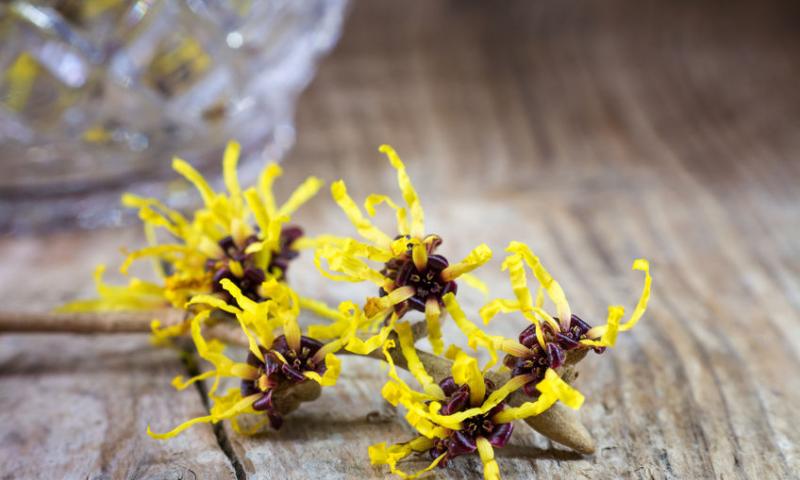 />
/>
ENGLISH NAME: Witch Hazel
LATIN NAME: Hamamelis virginiana
ORIGIN: Eastern North America
HABITAT: Europe, North America
BOTANICAL INFORMATION: Hamamelis virginian (lat. Hamamelis virginiana) belongs to the Hamamelis family (lat. Hamamelidaceae). Hamamelis genus (lat. Hamamelis) includes eight natural species and four varieties.
Witch Hazel is a shrub 6-8 meters in height. The crown is loose, bark of the branches is grey-brown in color and has light-grey draws, which are directed upwards. The leaves are elliptical, pointed, dentate, asymmetrical. Their length is 7-15 cm, and the width is about 8 cm. The color of the leaves is green above and light green below until the autumn. In fall, they change color: first to two-tone, yellow-green, then to golden-yellow with a reddish shade.
Flower buds swell on the shrub branches in late September, before the leaves fall. Later, inflorescences (1-5 flowers) appear in the leaves’ axils. Each flower has four long linear petals of yellow color, twisted in the form of a spring in different directions. Together with the fruits, which look like boxes 12-14 mm long, they remain on bare branches for a month. The fruits ripen only next summer of the year. They have egg shape. Cracking when ripening, they scatter black oblong seeds within a radius of several meters.
CHEMICAL COMPOSITION: The beneficial properties of Witch Hazel are explained by its balanced composition. Witch Hazel leaves and bark contain Tannins, Beta Ionone, Catechin, Copper, Flavonoids, Gallic Acid, Hamamelitannins, Iodine, Isoquercitrin, Kaempferol, Leucodelphinidin, Manganese, Myricetin, Phenol, Quercetin, Resins, Saponins, Selenium, Vitamin C, Vitamin E, Vitamin K, Vitamin P, Volatile Oil, Zinc and other effective components.
HISTORY:
- Hamamelis virginiana has such popular names as "Witch Hazel" and "Witch Nut." The reason for this is its late flowering, unusual for other plants.
- The prevalence of the “Witch Nut” was much wider: in the Paleo-and Neogene periods of the Cenozoic era, Witch Hazel grew throughout Europe and North America, reaching Greenland and Svalbard.
- As a garden plant, Witch Hazel is known since 1736.
*This article is for informational purposes only. We suggest consulting a physician before using these or any other herbal supplements.
